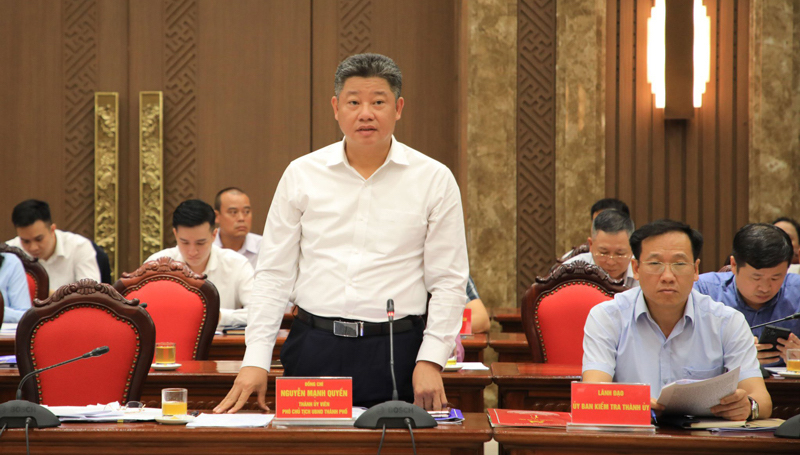Hanoi to remove bottlenecks to improve urban agriculture
Hanoi will soon become an ideal model for agricultural development associated with rural urbanization.
Vice Chairman of the Hanoi People’s Committee Nguyen Manh Quyen shared with Hanoimoi Newspaper that the city will focus on removing six “bottlenecks” to improve urban agriculture in the coming time.
| Vice Chairman of the Hanoi People’s Committee Nguyen Manh Quyen. Photo: hanoimoi |
Hanoi has the advantage of building urban agriculture associated with eco-tourism, how do you evaluate the potential?
Hanoi has immense potential to develop urban agriculture and a green economy in the context of climate change.
The area of agricultural production in the city is up to 200,000ha, accounting for nearly 60% of the total area. The population of the rural regions is 4.184 million people, accounting for 50.7% of the total.
The largely rural area of the city has its characteristics. It is home to many products with high artistic and technical value and a place to keep a treasure of historical and cultural relics with thousands of monuments and landscapes.
The capital also has many universities and research institutes with leading agricultural experts and is a large consumption market of high-quality farm products and tourism.
It is the foundation for Hanoi to move towards a green economy, of which the agricultural and rural economy is significant for the city's sustainable development.
Besides, the city has riverbanks, hills and plains, which can develop diverse high-tech, organic and ecological agriculture associated with experience tourism.
Suburban districts of Soc Son, Ba Vi, Phu Xuyen, and Ung Hoa are moving towards the new-style rural model with ecological spaces and increasingly modern infrastructure.
However, what "bottlenecks" should the capital’s agriculture remove to improve urban agriculture commensurate with its potential and advantages?
Currently, the city’s agriculture and rural areas are under tremendous pressure from the process of urbanization. Six " bottlenecks " need to be drastically removed in the coming time.
Firstly, farmers have switched from farming to other works due to a shortage of cultivation areas. With rapid urbanization, planning and construction of residential regions concentrated industrial parks, and socio-economic infrastructure works are under construction, leading to a large number of agricultural areas being divided, and stuck canals which are unable to serve irrigation and drainage.
Secondly, the substantial shift of the young labor force from agriculture to industry, construction and services has affected the labor force in agricultural production, lacking seasonal workers.
Thirdly, the production organization has not met the requirements of developing highly competitive agriculture. Production scale is mainly spontaneous, while land accumulation faces many difficulties and production costs increase.
Significantly, the value of agricultural production is lower than in other economic sectors, and farmers are not interested in agricultural production.
| A safe vegetable growing area in Chuc Son Commune's Chuong My District. Photo: Anh Ngoc/ The Hanoi Times |
Fourth is pressure from environmental quality. The amount of waste from animal husbandry, farming and aquaculture is increasing but has not been managed and treated thoroughly.
Fifth, mechanization in agricultural production has many limitations. The rate of deeply processed agricultural products is still low. Post-harvest preservation technology and waste products and by-products have been paid less attention to.
Lastly, current mechanisms and policies have not encouraged enterprises to invest in the agricultural sector, especially in applying high technology in cultivation, animal husbandry and processing.
What solutions will the city solve difficulties and challenges to turn its advantages?
The city encourages farmers to develop community-based tourism towards two goals: a relaxing space for urban residents on the weekend and a place worth living in.
Hanoi is also gradually forming high-quality seedling areas to meet the city's requirements and other localities for green urban development.
For example, Gia Lam District can form a high-tech garden house which supplies plant varieties for the whole region. Me Linh District will be home to ornamental flowers. Districts of Soc Son, Ba Vi, and Thuong Tin could be the land of organic agriculture associated with luxury eco-tourism.
So, what tasks does the city need to focus on?
In the coming time, Hanoi will continue to study and perfect the master plan, consult and propose the competent authorities to adjust the Capital Law, creating a legal basis for building mechanisms and policies for agricultural development.
I believe that if the above “bottlenecks” are solved, the picture of agriculture, farmers and rural areas of the city will change and soon become an ideal model for agricultural development associated with rural urbanization.
Thank you for your time!











